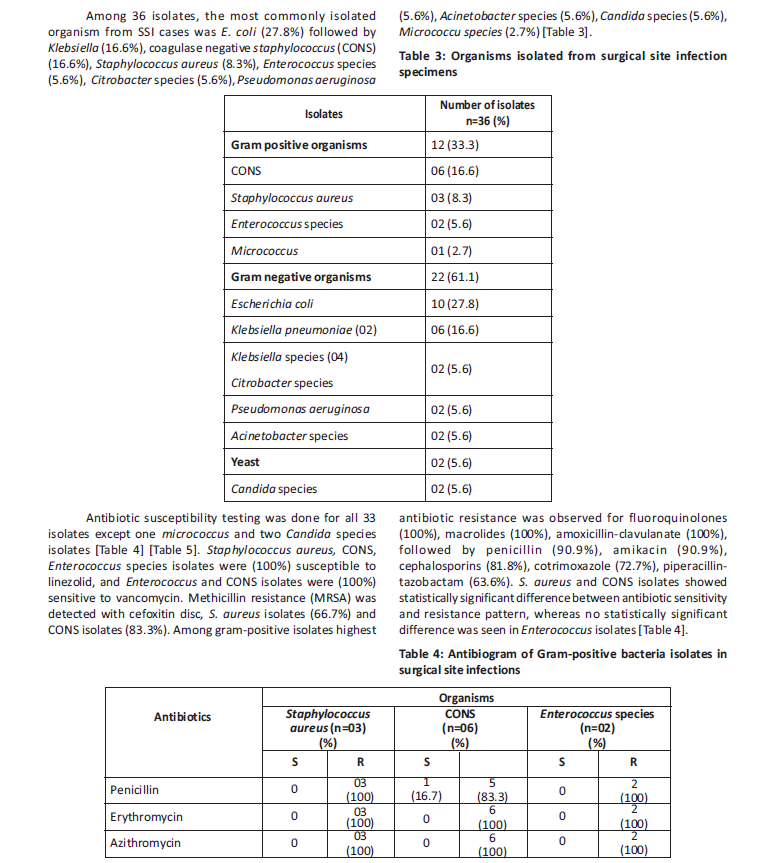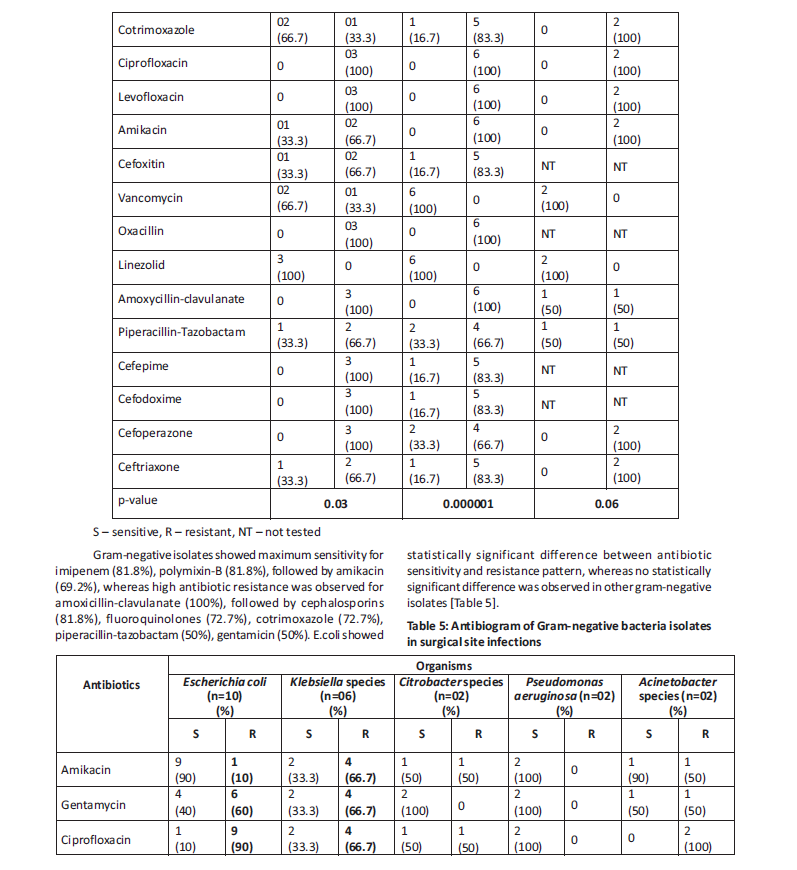
Original Article
Year : 2019 | Volume : 7 | Issue : 2 Page : 43-49
Palange P1, Ambade V2Wilson V3, Mohan Rao B4
1Associate Professor, Department of Microbiology, Prathima Institute Of Medical Sciences,Nagnur Road,Karimnagar
2Associate Professor, Department of Microbiology, Late Atal Bihari Vajpayee Memorial Medical College, Rajnandgaon, Chattisgarh
3Professor Of Community Medicine, Prathima Institute of medical Sciences, Nagnur road, Karimnagar
4Professor and HOD, Department of Microbiology, Prathima Institute of medical Sciences, Nagnur road, Karimnagar
*Address for correspondence:: Dr. Padmavali N. Palange , Department of Microbiology , Prathima Institute of medical
sciences,nagnur road, Karimnagar. Mobile 9011481059
E mail ID: - padmavali@gmail.com
Background: Surgical site infection (SSI) is one of the common causes of nosocomial infections. Nosocomial infections are responsible for a prolonged hospital stay and also associated with increased morbidity, mortality, and increased economic burden on the patients and family as well as overburden the hospital staff. Globally overall SSI rate varies from 2.5% – 41.9% resulting in high morbidity and mortality.
However, a simple step such as hand washing, knowledge of bacteriological profile of SSIs in a hospital, and antibiotic susceptibility pattern of those isolates would help clinicians in choosing the empirical antibiotic treatment and curtail the SSIs. Objectives: The present study was undertaken to determine the prevalence of SSI, to isolate the causative organisms, and to study their antibiotic susceptibility pattern in a hospital.
Materials and methods:
The present hospital-based, cross-sectional study was conducted at a tertiary care teaching hospital in northern Telangana, India, from August 2017 to June 2018. All pus specimens from patients of clinically suspected SSIs that were received in the microbiology laboratory were processed as per standard microbiological techniques. The data recorded and maintained in the microbiology laboratory register was reviewed and analyzed for the study. Data was analyzed by calculating the percentages and applying the Chi-square test.
The p-value <0.05 was considered as significant.
Results : We observed that during the study period, 2249 major surgeries were conducted and out of these, a total of 77 pus specimens from patients clinically suspected of SSIs were received in the microbiology laboratory. 36 (46.7%) specimens were culture positive giving 36 isolates. The SSI prevalence rate was 3.4%. Females (54.5%) were affected more than males (45.5%). The most commonly isolated organism from SSI cases was E. coli (27.8%) followed by Klebsiella species (16.6%) and coagulase negative staphylococcus (CONS) (16.6%).
Conclusion:
In this study, SSI prevalence rate was 3.4%. The most commonly isolated organism from SSI cases was E.coli (27.8%).
The gram-negative bacilli showed better sensitivity to imipenem and polymixin B. Majority of the gram-negative bacilli showed less sensitivity to the other commonly prescribed antibiotics like cephalosporins, fluoroquinolones, cotrimoxazole, piperacillin-tazobactam, gentamicin.
Knowledge of the common pathogens and their antibiotic susceptibility status can guide clinicians to choose appropriate antibiotics for the empirical treatment of patients.
Keywords: Antibiotic susceptibility pattern, Bacteriological profile, Surgical site infections (SSIs).
INTRODUCTION
Surgical site infection (SSI) is the third most frequently reported nosocomial infections. SSI contributes to about 15% of all nosocomial infections which have an adverse effect on patient and hospital (1, 2). SSI causes prolonged hospital stay to a patient and more economic burden to the patient and family (1, 3). SSIs shows multifactorial association like patient condition, pre-existing disease, exogenous or endogenous etiological agent, drug resistance, hospital environment, and many others related to the operation. The spectrum of microorganisms isolated from SSI varies greatly from time to time, hospital to hospital as well as developed to developing countries (4, 5). Globally overall SSI rate varies from 2.5% – 41.9% resulting in high morbidity and mortality (6, 7). To curtail the nosocomial infections, continuous surveillance of SSI is required which would help to formulate hospital infection control strategy and antibiotic policy in a hospital. Moreover, a clinician’s awareness regarding most frequent microbes causing SSI, and their changing antibiotic sensitivity pattern in a hospital would definitely reduce the SSI rate in any hospital.
With this background, the present study was undertaken to determine the prevalence rate of SSI, to isolate the causative organisms, and to study their antibiotic susceptibility pattern in a hospital. This study would also help in a formulation, implementation as well as evaluation of the hospital infection control measures and antibiotic policy in a hospital.
MATERIALS AND METHODS
The present hospital-based, cross-sectional study was conducted at a tertiary care teaching hospital in northern Telangana, south India, from August 2017 to June 2018. All pus specimens clinically suspected of SSI sent to the microbiology laboratory were processed as per standard microbiological techniques. All the specimens were cultured on blood agar and MacConkey agar, incubated at 3700C for 24- 48 hours before being reported as sterile and organisms were identified by colony character, gram stain, motility, biochemical tests (8). Antibiotic susceptibility testing was done using a modified Kirby-Bauer disc diffusion method on Mueller-Hinton agar and results were interpreted as per CLSI guidelines (9).
Antibiotic discs were obtained from HiMedia. The data recorded and maintained in the microbiology laboratory register was reviewed and analyzed for the study. Data was analyzed by calculating the percentages and applying the Chisquare test. The p-value <0.05 was considered as significant.
RESULTS
A total of 2249 patients underwent major surgeries in various departments (surgery, orthopedics, obstetrics, and gynecology) from August 2017 to June 2018. Patients clinically suspected of having SSIs were 77 (3.4%) of whom specimens were sent to the microbiology laboratory. Out of 77 specimens; 40 (51.9%) specimens were sterile, while one specimen had grown aerobic spore bearers (contaminant) and 36 (46.7%) specimens were culture positive giving 36 isolates. Out of these 36 isolates, 34 (94.4%) were bacterial isolates and 2 (5.6%) were fungal isolates.
Majority of the SSIs were observed in >50 years age group (31.2%). Females (54.5%) were affected more than males (45.5%). However, in the present study, there was no statistically significant difference in the rate of SSI between male and female [Table 1].
Table 1: Age and gender-wise distribution of surgical site infections






Open Access
Perspectives in Medical Research is committed to keeping research articles Open Access.Journal permits any users to read, download, copy, print, search, or link to the full texts of these articles...
Read more
